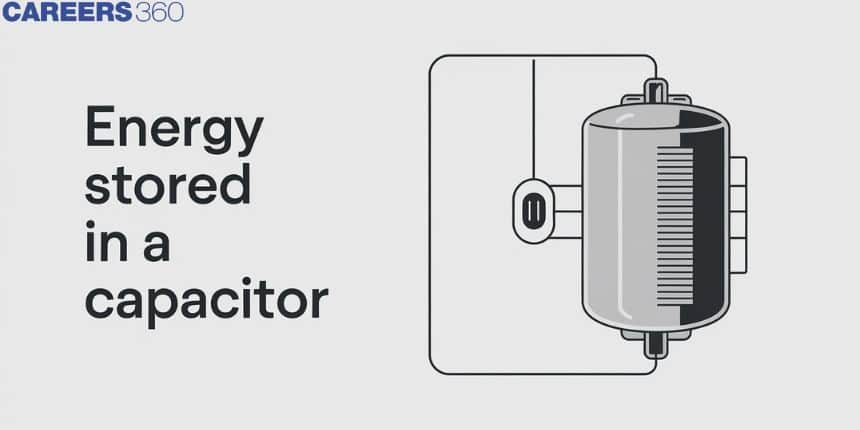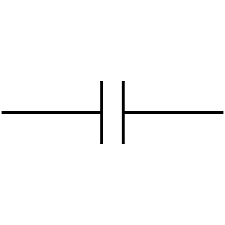Energy Stored in a Capacitor - A Complete Guide
Imagine a camera flash. If you press the button, it produces light. The flash requires additional energy to produce that light. This energy is stored in a Capacitor inside the camera. the capacitor charges up when it is connected to the battery and energy is stored in it and then gives out all energy, thus creating the flash. In this article, we will study Capacitor and its working. We will also study the expression of energy stored in capacitors. In the later part, we will derive the equation of energy stored in a capacitor followed by work done by the capacitor.
This Story also Contains
- What is a capacitor?
- Formula for Capacitance
- Working of Capacitor
- Application of Capacitor

What is a capacitor?
A capacitor is a device consisting of two conductive plates separated by an insulating material known as a Dielectric. Basically, it is an electric component that stores charge in the form of an electric field.
SI unit of Capacitance (C)
Capacitance is measured in farads (f).
1 farad ( $F$ ) is defined as the capacitance of a capacitor that, when charged with 1 coulomb ( $C$ ) of electric charge, results in a potential difference of 1 volt $(\mathrm{V})$ across its plates:
$$
1 \mathrm{~F}=\frac{1 \mathrm{C}}{1 \mathrm{~V}}
$$

Formula for Capacitance
Thus capacitance is given by the formula:
$$
\mathrm{C}=\mathrm{q} / \mathrm{V}
$$
Where,
- $q=$ charge develop on each plate
- $\mathrm{V}=$ voltage between them
Also Read
Working of Capacitor
It works on principles of Coulomb’s law in which like charges repel each other while unlike charges attracts each other thus unlike charge polarity gets induced on the inside surfaces of charged plates of a capacitor. The conductor thus holds equal and opposite charges inside the surface and thus the formation of electric field inside the non-conducting region.
Here's a simple breakdown of how Capacitor works:
- Charging: When it gets connected to a power source, one plate gains a positive charge and the other one gets a negative charge. This creates an electric field between the plates, storing energy.
- Storing energy: These plates hold this energy in the electric field as long as it is connected to a power source.
- Discharging: When disconnected from the source and connected to a circuit, the stored energy flows out, creating a current until the plates have an equal charge.
|
Related Topics |
Derive the expression for energy stored in a capacitor
Capacitors not only store charge but store energy as well thus when it is connected to the circuit there is decrease in charge as well as transfer of charge takes place.
Consider a parallel plate capacitor. Let C be the capacitance at time t. Charge on the capacitor and the potential difference between capacitor plates is zero. Potential difference increases when the charge is given. Then potential difference between its plate is V=q/C where q is the charge at any instant.
Work done in providing more charge is given by:
$$
\begin{aligned}
& \mathrm{dW}=\mathrm{Vdq} \\
& \mathrm{dW}=\mathrm{dq} \mathrm{q} / \mathrm{C}
\end{aligned}
$$
On integrating the equation from 0 to 1 , $\mathrm{E}=\mathrm{Q}^2 / 2 \mathrm{C} \quad$ (Work Done)
We know that charge, $\mathrm{Q}=\mathrm{CV}$
Total energy stored in the capacitor,
$$
\begin{aligned}
& \mathrm{E}=\mathrm{Q}^2 / 2 \mathrm{C} \\
& \mathrm{E}=\mathrm{CV}^2 / 2 \\
& \mathrm{E}=\mathrm{QV} / 2
\end{aligned}
$$
Work done by the capacitor
Work done by the capacitor to accumulate charge inside it is equal to Energy stored inside the capacitor.
Or it is given by
$\mathrm{W}=\mathrm{Cv}^2 / 2$
Power of the capacitor
We can determine Power of the capacitor by multiplying the voltage (V) across terminals and current(I), or
$\mathrm{P}=\mathrm{VI}$
Application of Capacitor
- Capacitor has been widely used as a storage device for the energy produced.
- It can be used as a dissipated battery, as it stores energy when connected to the circuit and delivers that energy when it gets disconnected from the circuit.
- Large capacitors are used in industrial power systems to improve power factor, reducing energy losses and improving efficiency.
- Capacitors are used to improve the power factor and minimize energy loss.
- Capacitors give a kick-start in some low-voltage appliances like fans, and compressor electric motors.
Frequently Asked Questions (FAQs)
1 Both Electric potential energy and potential difference decreases.
2 Electric potential remains the same and potential difference increases.
3 Electric Potential remains the same and the potential difference decreases.
4 Both Electric Potential energy and Potential difference increases.
We know, when the capacitor is disconnected then there is flow of charge and Electric Potential Energy remains the same , as charge keeps on decreasing so does potential difference. Hence the correct answer is option(3).
Capacitor energy is the work by which the capacitor gets charged.
Electrical potential energy
Capacitance, C=q/V
Where, q= charge develop on each plate
V= voltage between them
Coulomb
Mica capacitor, film capacitor, ceramic capacitor, paper capacitor etc.
As we know, E=Q2/2c, thus E∝Q2
Hence on doubling the value of Q, Energy stored
becomes 4 times. Hence the correct option is (3).